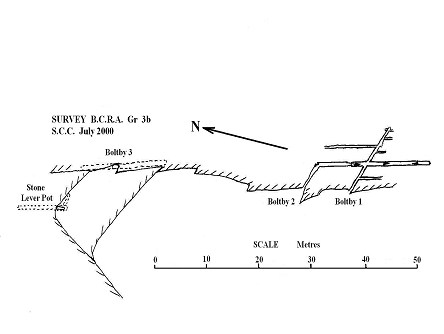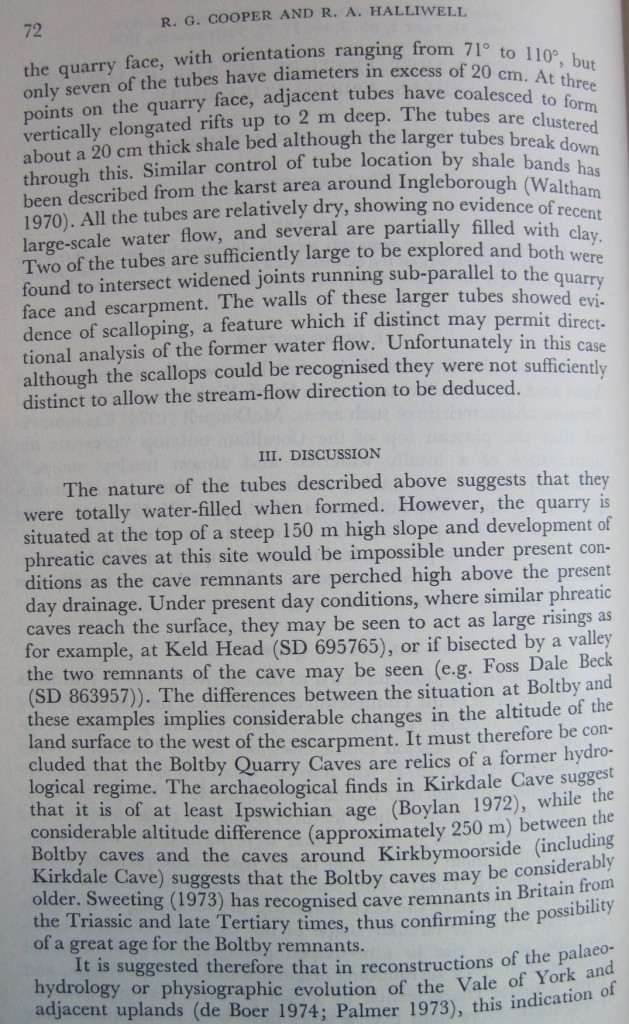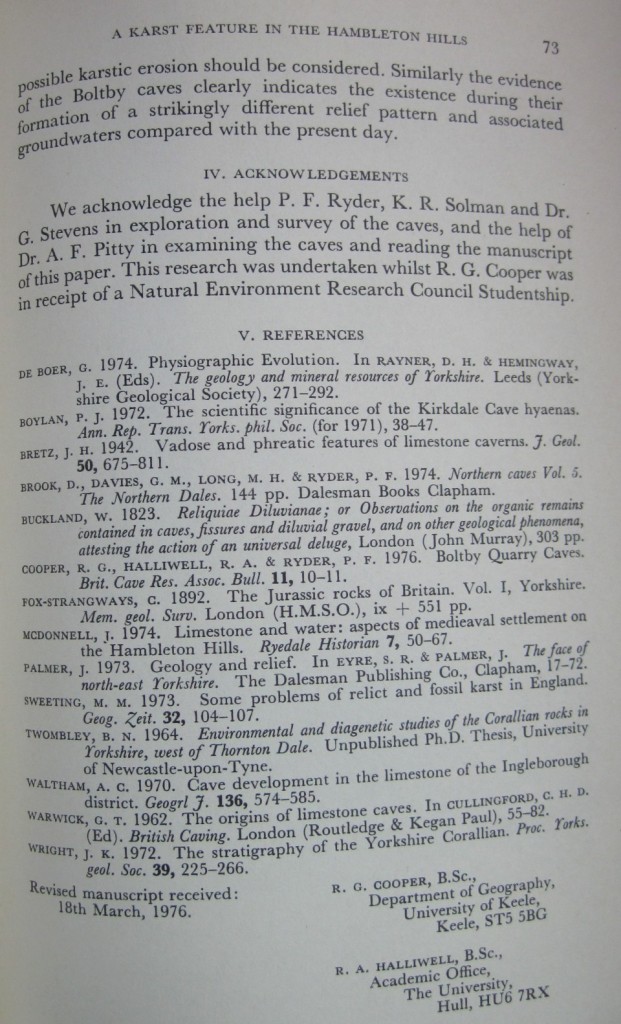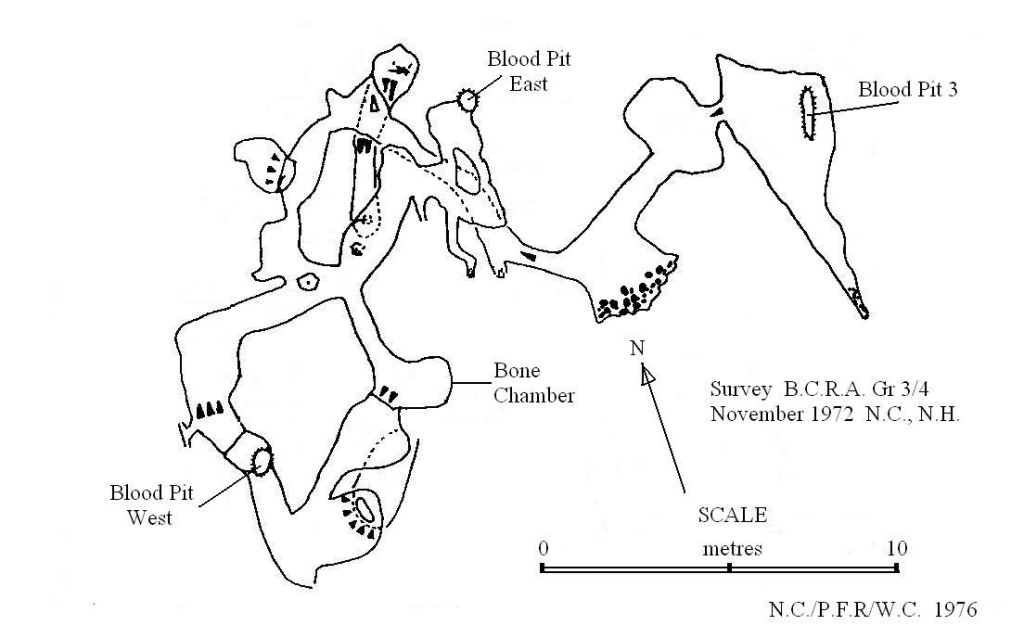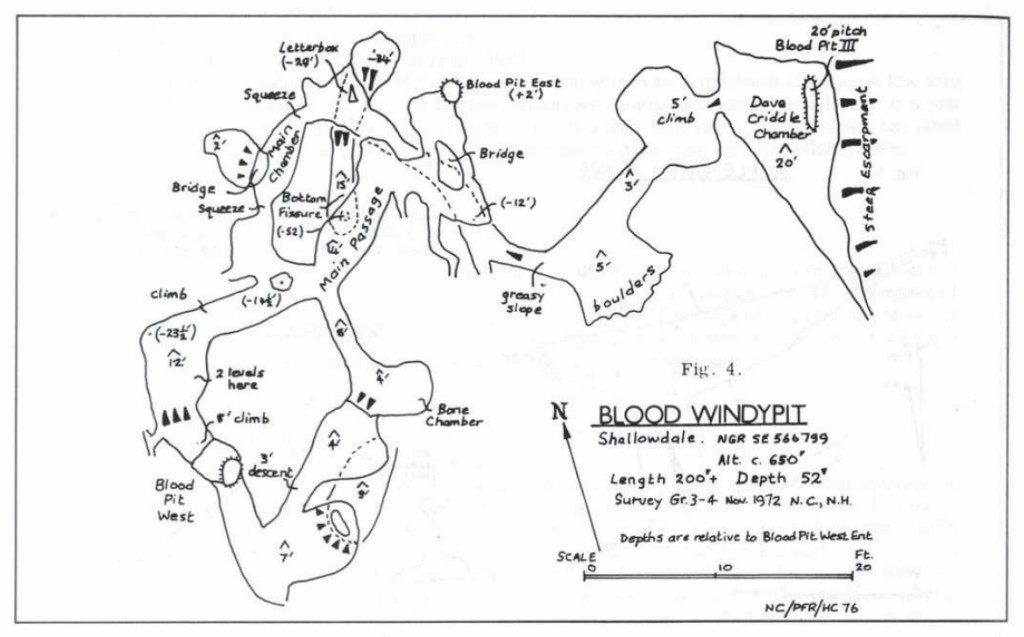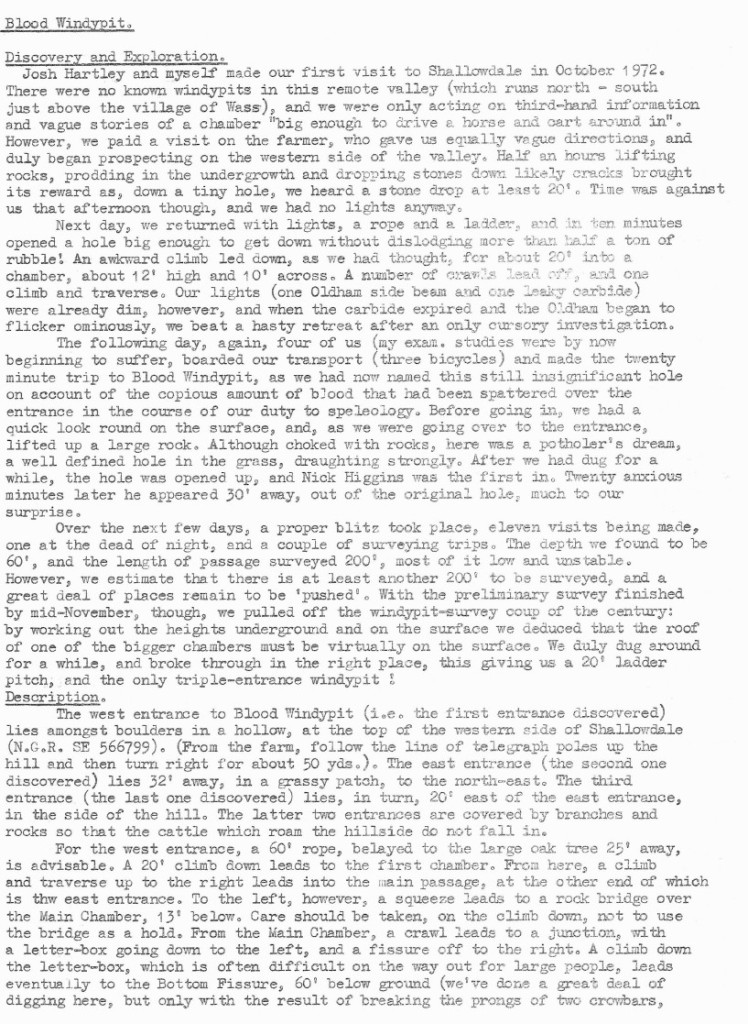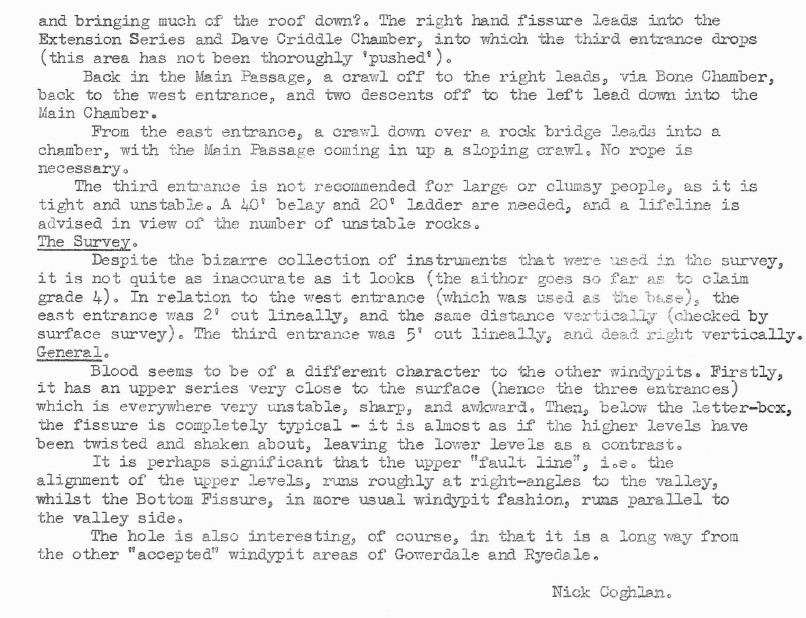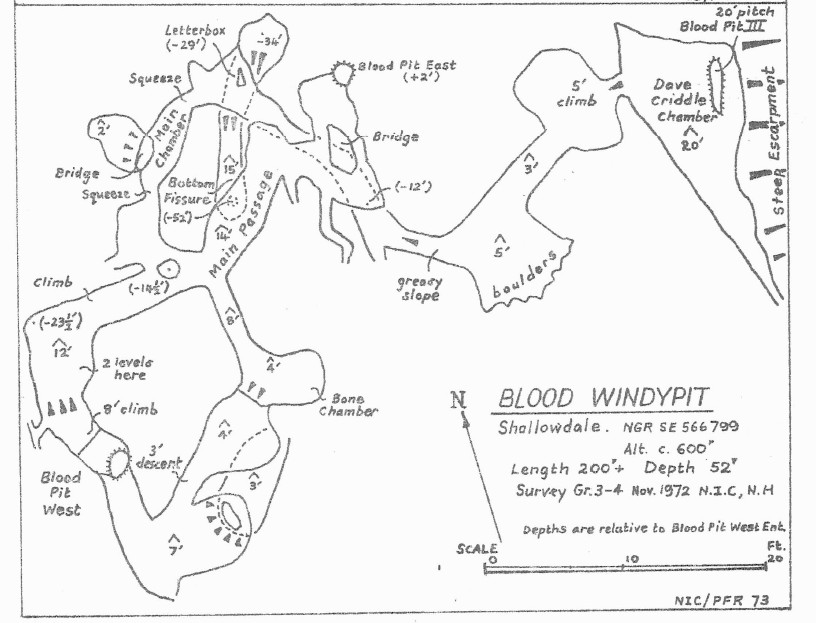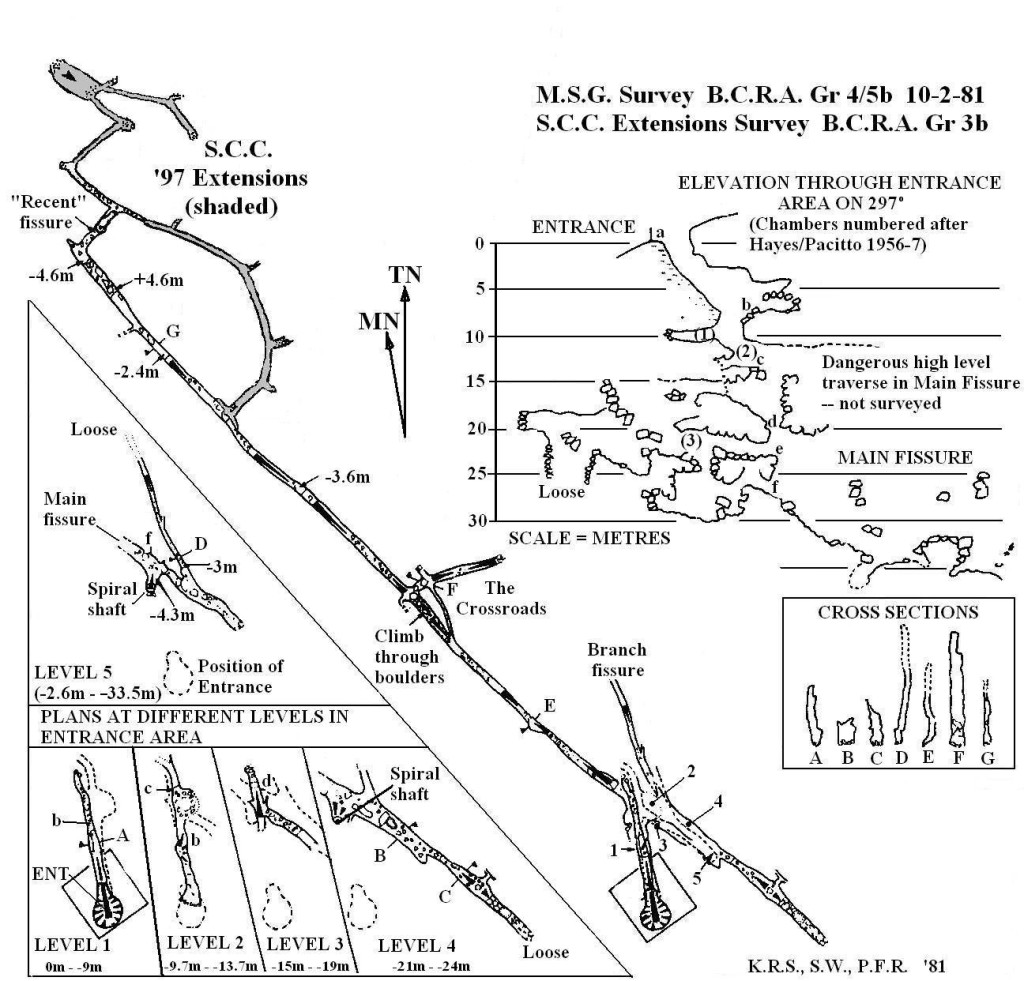Moorland Caver (2003)
NGR: SE 570850
Altitude: 150m
Access: Permission to descend is not granted.
Warning: Beware of loose rock, esp. in Ashberry II.
ASHBERRY I
Length: 110m
Depth: 28m
Grade: II
Entertainment Value: III
The entrance is a large, open sloping hole, below a tree; best descended using a handline (for the return). The way on lies to the East end of the entrance chamber. A short climb down leads to a choice of routes. That to the right drops into Chamber C with no way on. (This chamber yielded a variety of archaeological material during the 1950s). The main way on lies down a narrow descending rift on the left hand side. Climb down at the foot of the rift into a roomy boulder chamber known as chamber D. Exiting the chamber at its bottom (lowest) end brings one to the top of a 9m pitch into the main rift.
The pitch can be by-passed by using Dowsons Route: Take the left before the head of the pitch and insert oneself through a letterbox into a small boulder chamber. Just below the letterbox is a hole; this is the head of a 4.5m climb down into the main rift (best tackled on a short ladder or handline belayed to a boulder in the chamber). The climb lands in the main rift, back from the foot of the 9 m ladder pitch. A boulder slope at the North End of the main rift can be climbed giving access to a further, short section of the Main Rift. The route to the deepest point starts near the foot of the climb on Dowsons Route. A crawl in a small passage (a less than obvious continuation of the main rift) leads to a hole in the floor – the lowest point in the system. The passage ends in a choke, which is believed to lie very close to Ammonite Rift in Ashberry II.
Tackle:
Entrance: 6m handline, belay to tree (optional).
Main rift: 9m ladder, belay to boulders (long belay).
Dowsons Route: Handline or 5m ladder, spreader, sling (optional).
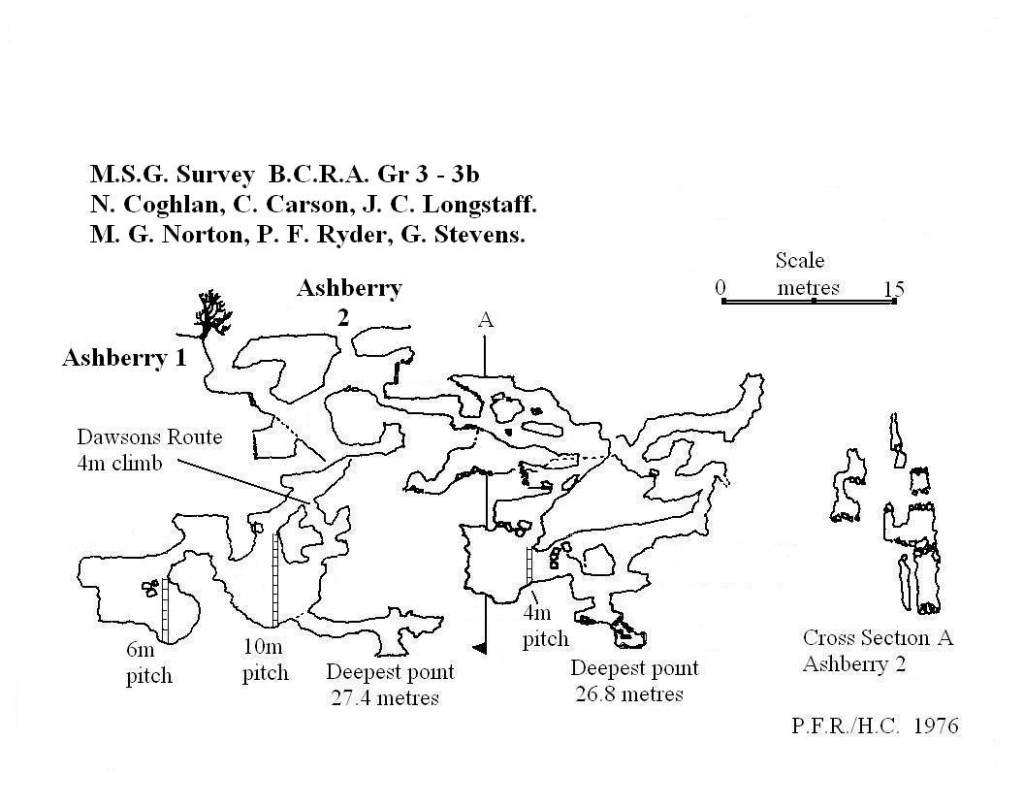
ASHBERRY II
Length: 210m
Depth: 27m
Grade: III
Entertainment Value: IV
N.B: Care is needed to prevent (further) damage to fine moonmilk formations.
The entrance lies 9m south of Ashberry I and is easily found by following a well worn path. Although the 4.5m entrance is free climbable either a ladder or a handline is useful. The way on lies at the South end of the entrance chamber; an excavated pit drops down to a short, 40 cm high section best tackled feet first. Once in, follow the right hand wall to a 1.2 m climb down into a boulder chamber. This chamber is a main junction and, as such is the key to the system with various routes radiating from this point:
Letterbox Route: Follow the chamber up to the left where a rift in solid rock will be encountered. Drop down into the rift and climb down to the left (right leads to the deepest point), which brings one to “Fourways Junction”. From the junction traverse down the right hand rift which soon opens out into a spacious chamber. At the far end of the chamber is a “letterbox” connecting to a parallel fissure; carefully note the letterbox for the return journey as it is very easy to loose the way out (voice of experience)! Emerging from the letterbox turn left into a boulder chamber; two different routes are possible from here: Firstly there is a climb up to the right which can be followed up through a series of rather unstable (care) boulder chambers to a point quite near the surface – all in all, rather uninspiring stuff. Alternatively one can follow the more normal route from the boulder chamber, i.e straight ahead which leads to a 2 m climb down. From the foot of the climb follow the passage for a few metres to a small and unstable chamber with a hole in the floor. The hole is a narrow 4.5 m chimney down to Upper Windlet Chamber.
Intermediate circuit: From the 1.2m climb into the Junction Chamber follow the right hand wall until a corner is reached. Drop through the hole in the floor to emerge into a low roomy chamber (note the hole should you need to return this way). The bottom end of the chamber opens up into a roomier chamber with a slope on the right and a narrow fissure on the left. The fissure on the left quickly opens up into a blind chamber. The way on lies up the slope on the right.
At the top of the slope there are two practicable routes: A climb up to the left that leads into a short blind passage. The alternative (and the way on) is a thrutch up through boulders on the right which brings one back to Fourways Junction on the “Letterbox Route”.
Main Route to deepest point: From the top of Junction Chamber climb down into the rift and follow it to the right (best tackled as low down the rift as possible). The Rift opens out into quite a large boulder chamber with various holes in the floor. A climb down through a hole lands in a smaller chamber at the head of a 3.5m climb. From this chamber a rather devious route to the left leads to Upper Windlet Chamber and the foot of the 4.5m chimney from the Letterbox Route. The 3.5m climb is rather an awkward proposition as a free climb and is best laddered. The climb lands in Ammonite Rift. The boulder choke at the Northern end of the rift is very close to the end of the Main Rift in Ashberry I and draughts strongly. Digging here might produce a through route into I (CARE REQUIRED !!!). The southern end of the rift continues into Lower Windlet Chamber (and the deepest point). A climb up through boulders at the far end of Lower Windlet brings one into Upper Windlet Chamber.
A Round Trip: From the entrance head to Junction Chamber, follow the intermediate circuit to Fourways Junction. From Fourways take the Letterbox Route, via the chimney down to upper Windlet Chamber. Cross Upper Windlet to the Chamber at the head of the 3.5m climb. Down the climb into Ammonite rift, into Lower Windlet and then climb back into Upper Windlet. Retrace your steps back to the head of the 3.5m climb and then climb up, through one of the holes, into the boulder chamber. Follow the rift out of the chamber back to the Junction Chamber and out.
Tackle
Entrance: 5m ladder, spreader and sling, belay to tree near open hole.
3.5m climb: 5m handline or 5m ladder, spreader and sling, belay to rock bridge at head of climb.
History
Although Ashberry must have been known locally for a significant period the first recorded descent took place in November 1935 when Roberts, Brown, Gowing and P.O.Armstrong of the Y.R.C. examined Windypit III at Ashberry. In 1943 Hayes and a party of five boys descended the main fissure, Edgar Dowson (of Dowson Pot (q.v) “fame”) discovered a short climb up out of the western end of the rift.
After clearing a considerable amount of rubble a climbable pitch bypass was opened up.
During their series of explorations in 1949 Ashberry was visited by the B.S.A. who produced a survey, however they did not manage to enter new territory. They were aware of the pitch bypass which they named “Dowson’s Passage” after its finder.
The 1955 archaeological finds in Antofts (q.v) stimulated a new interest in Ashberry, resulting in a considerable amount of digging on the part of Hayes and his associates, finds being made at four locations within the windypit. Having concluded their archaeological work in Ashberry I the diggers turned their attention to Ashberry II, first recorded by the B.S.A. in 1949. Work in Ashberry II appears to have commenced in 1959 when Bill Lamplough started clearing rubble at the foot of the small entrance shaft, however work appears to have been half hearted, attention having shifted to the excavation of fissures S, T, and U in Bucklands (q.v).
In 1971/72 a local archaeological society, digging in the entrance chamber dug their way into a new series of passages and chambers, opening up the maze like ramifications of Ashberry II. Who first explored the extension is open to question, however it is certain that the M.S.G. undertook the first complete exploration, during which they produced the definitive survey.
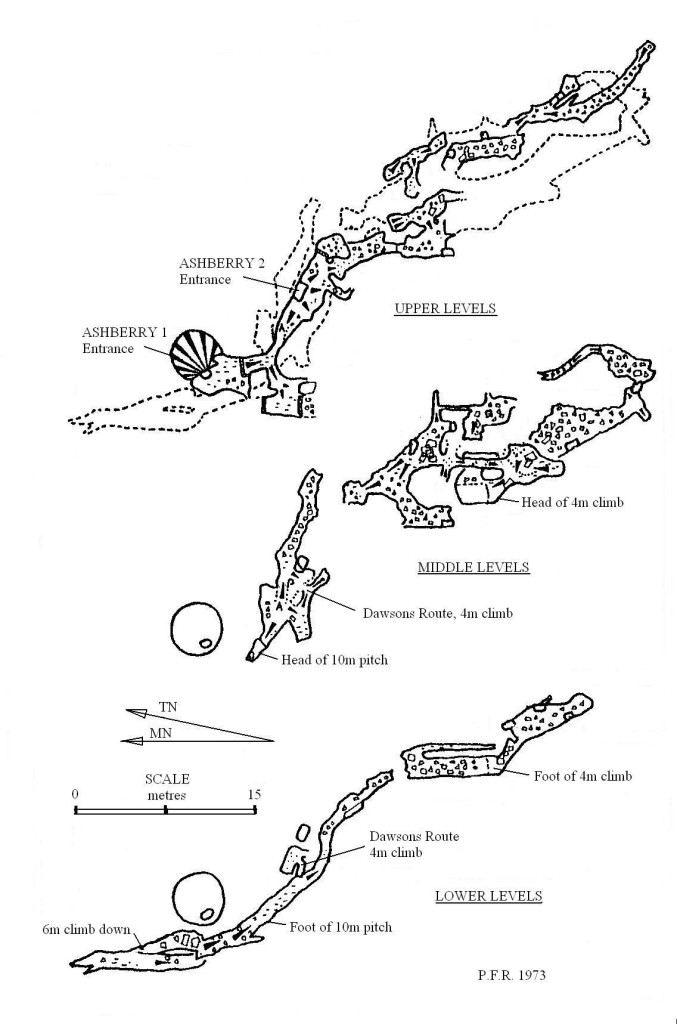
Memoirs of a Moldywarp (2008)
The first windypit we had a good look at, in 1972 was Ashberry, on a hill overlooking the ruins of Rievaulx Abbey. Here was a hole quite different to most Dales potholes. In the middle of a wood, it was just a yawning black hole under a tree, for all the world like a huge fox earth, all dead leaves and dank breath. Another smaller hole alongside was Ashberry II, where we had heard a local archaeological group had dug into an extensive series of ‘new’ passages and chambers. We found both holes to consist of a bewildering maze of rifts and chambers; in places three parallel rifts had opened up, with lots of precariously poised boulders; at the lowest point in Ashberry II a strong draught blew in from an impassable fissure, the Windlet. Surveying the complex was not easy, and drawing out the survey so that it made sense to the beholder even more difficult, as there were several superimposed levels of passages. Some years later there. was a Cave Rescue Organisation callout to Ashberry ; they apparently went in clutching our survey, which I don’t think really helped them. Fortunately the missing cavers were (quite predictably) simply lost, and were easily retrieved.
BCRA Transactions – Vol.3 No.2 – The North Yorkshire Windypits (1976)
Ashberry Windypit 1. SE570850 Altitude 500 ft. Length 360 ft. Depth 92 ft.
References: Anon., 1936b; Fitton Et Mitchell, 1950; Mitchell, 1956; Jackson, 1962; Hayes, 1963a, 1963b, 1963c, Brittain, 1965; Ryder, 1973; Brook et al., 1974.
The Ashberry windypits are situated in woodland on the east side of Ashberry Hill, on gently sloping ground about 10 ft. below the crest of the hillside overlooking Rievaulx Abbey. They consist of two more or less separate series of rifts and fissures, with separate entrances, but connected about 20 ft. below ground level by a very narrow rift. At Ashberry Windypit 1 an easy free climb down into a chamber leads to a descending rift below a small stone wall built by archaelogical excavators. In the roof of the main descending rift is the tight connection with Ashberry Windypit 2. The main route spirals down, with various short branches, through a maze of huge jumbled boulders, to the head of a 30 ft. pitch into the main rift . Dowson’s Route is an alternative, involving a 15 ft. climb with a fixed handline, leading into the south end of the main fissure. A short crawl and an 18 ft. climb down lead to a further short section of the main rift, closing down to the north and choked to the south. At the south end of the main rift, a low passage at floor level continues south for about 40 ft, ending in a choke a few feet short of Ammonite Rift in Ashberry Windypit 2. A narrow rift in the floor of this passage drops a further 10 ft. to the deepest point in the system.
The slot drops into a low bedding plane crawl, which, becoming roomier, opens to a 4 ft. drop down into a low boulder-strewn chamber with three ways on. The ensuing complexity is clear from the survey (Fig.12). A full description was given by Ryder 119731. The slipping that has taken place in the formation of the Ashberry system appears to have been not quite at right angles to tiie joints or pre-existing fissures in the rock, and thus a zig-zag plan has resulted (Davies and Ryder, 19731. The same pattern of slipping is also seen in the more complex higher levels, with individual blocks of hillside moving in various directions, not necessarily parallel to those above and below, between different bedding planes. In parts of Ashberry Windypit 2 there appear to be two more or less parallel rifts running alongside each other.
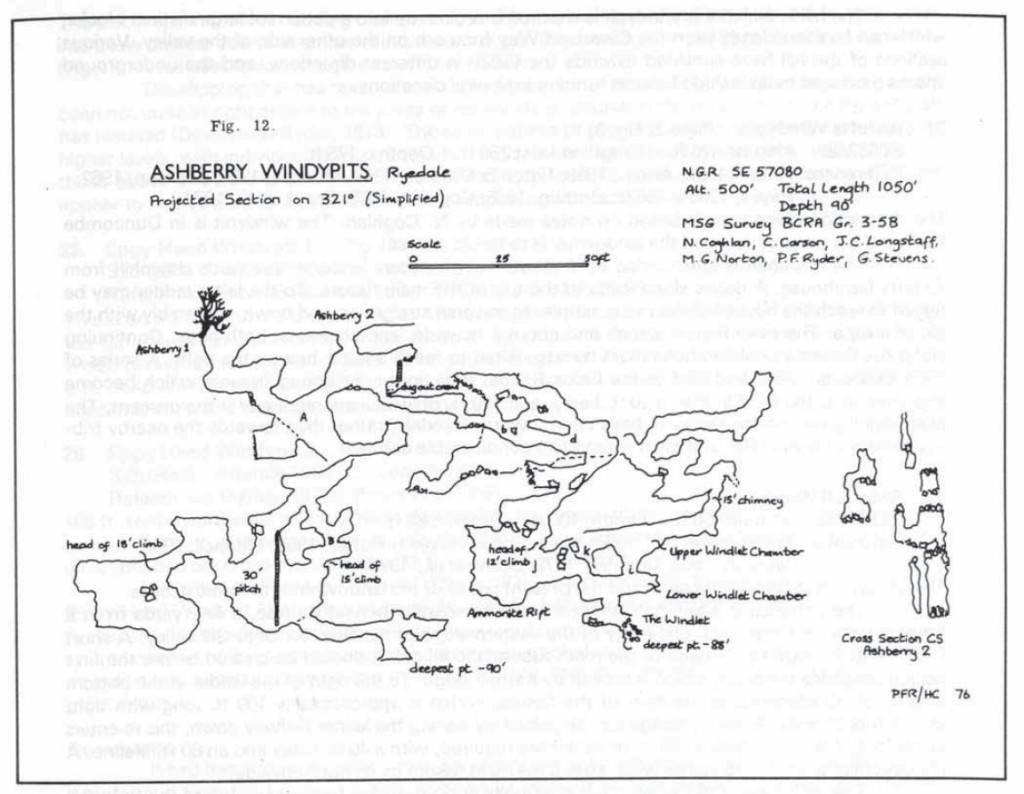
Ashberry Windypit 2. SE570850 Altitude 500 ft. Length 690 ft. Depth 88 ft.
References: Ryder, 1973; Brook et al., 1974. This has a smaller entrance 30 ft. south of the gaping crater of Ashberry Windypit 1. It was long thought to consist of a single chamber only, with its narrow connection with Ashberry Windypit 1. However, in 1971 a local archaeological society, digging in this chamber, broke through into a considerable series of further passages and chambers. At present the way into these chambers has once more become blocked. The small entrance drops 12 ft. into a roomy chamber; a handline or short ladder is convenient. To the north is the narrow fissure connecting with Ashberry Windypit 1, and to the south is a strongly draughting slot at the foot of the chamber wall, which leads into the new series’.
Northern Caves Volume 5 – (1974)
ASHBERRY WINDYPIT NGR SE.570850 Grade II Alt. 500ft. (153 m.) Length 1,050 ft. (320.3 m.) Depth 90 ft. (27.5 m.) On Ashberry Hill, just below crest of wooded slope facing Rievaulx Abbey. Follow track branching left from Old Byland to Rievaulx road, and c. 100 yds. (91.5 m.) before gate into open field, turn left into wood and search for hole. An intricate and extensive windypit, some danger from loose rock. Ashberry I Entrance is an obvious crater beneath a tree. A series of roomy rifts and chambers spiral down to head of 30 ft. (9.1 m.) pitch into the Main Rift. This can be avoided by using Dowson’s Route—take first left before head of pitch, and series of small descents and final 15 ft. (4.5 m.) drop, where a handline is useful, provide an easier route into the Main Rift. To N is a climb up a boulder slope, short crawl, and 18 ft. (5.4 m.) climb down into short further section of Main Rift. To S., below foot of climb on Dowson’s Route, is a smaller passage, a hole in the floor of which is the deepest point in the system, ending in a choke a few feet from Ammonite Rift in Ashberry II Series. Ashberry II. Small entrance 30 ft. (9.1 m.) S of Ashberry I entrance. 15 ft. (4.5 m.) descent (rope useful) into chamber. To N is very tight rift connecting with Ashberry I, to S a low crawl leads into a very complex series of chambers and rifts. Route to deepest point is found by taking first possible branch on left (not hole in roof), and right at first junction along a narrow rift, dropping into a chamber, with a false floor. Climb down into chamber beneath, then down slope onto rock bridge in Ammonite Rift—this area is very unstable. 12 ft. (3.6 m.) climb to floor of Rift, to N boulder choke, to S crawl into Lower Windlet Chamber, with on left in floor narrow rift draughting strongly—the Windlet. There are a variety of other passages and chambers, too complex to be easily described.
Moldywarps Speleological Group – Journal 6 (1973)
Ashberry Windypit consists of two more or less separate series of rifts and fissure with separate entrances, but connected, about 20′ below ground level, by a very narrow rift. Ashberry I, the deeper series, has been known for many years, and is described in the ‘Cave Science’ article. Ashberry II, with a smaller entrance 30′ south of the gaping crater of Ashberry I, was long thought to consist of a single chamber only, with its narrow connection with Ashberry I. However, in 1971, a local archaeological society, digging in this chamber, broke through into a further series of passages and chambers of considerable extent. Location. Ashberry Windypit is situated in woodland on the east side of Ashberry Hill, on gently sloping ground about 10′ below the crest of the hillside overlooking Rievaulx Abbey. Due to their complexity, written descriptions of windypit tend to be inordinately long, and not very illuminating, surveys of them provide their unravellers with absorbing mental puzzles. The survey of Ashberry here reproduced shows the plan divided into three, the passages and chambers being conveniently divided into three different levels (although there are no such distinct separate levels in actuality – the division is quite arbitrary, merely for the purposes of the clarity of the survey). A fairly brief written description of the main routes in the system, to be used in conjunction with the survey, is given here. Ashberry 1: Length 360′, Depth 92′, The entrance crater of Ashberry I is easily scrambled down, no tackle being required, into a chamber, from which a descending rift, below a small stone wall built by archaeologists, leads downward,. To the r. is a second chamber, also showing evidence of attention from archaeologists. In the roof of the main descending rift (point ‘A’ a survey) is the tight connection with Ashberry II. The main route spirals down, with various short branches, to the head of a 30′ pitch into the Main Rift. Turning I. before the head of the pitch, and I. again through a small hole into a little chamber (‘B’ on survey) leads to a 15′ climb with (in 1972) a fixed handline. Dowson’s Route into the south end of the Main Rift, The Main Rift is 4′ wide and 30′ high, running north past the foot of the 30′ pitch, to a climb up muddy boulders into a high chamber with some moonmilk on the walls, A short crawl and an 18′ climb down leads to a further short section of the Main Rift, closing down to the north and choked to the south. At the south end of the Main Rift, a low passage at floor level continues south for c.40′, ending in a choke a few feet short of Ammonite Rift in Ashberry II. A narrow rift in the floor of this passage drops a further 13′, the deepest point in the system.
Ashberry II, Length 690′, Depth 88′.
The small entrance drops 12′ into a roomy chamber – tackle is not essential, but a handline or short ladder can be used. To the north is the narrow fissure connecting with Ashberry I, to the south a slot at the foot of the chamber wall, draughting strongly, leading into the ‘new series’. This slot drops Into a low bedding, which opens into a roomier crawl, to a 4′ drop down into a low bouldery chamber with three ways on. Straight ahead is a hole in the floor (‘a’ on survey), and to the I. a descending passage (‘b’) divided into two horizontally by a rock bridge, with above its entrance an opening in the roof leading up into a rather larger chamber, with one other route out, a descending rift (‘d’). Descending hole ‘a’, one enters a low chamber directly below that which one has just left, with a route on through boulder ruckle into a larger chamber with an obvious ‘aven’ in the roof (‘e’). At the top of this, an easy 15′ climb, are some short muddy passages which soon end. The chamber at ‘e’ can also be reached by following the passage ‘b’ from the point at which the routes divide, and turning l. at the first junction. Straight ahead. at this junction opens into a roomy chamber running to the r. (entered at ‘c’ on survey). To the l. a hole down through boulders (‘f’) leads back to chamber ‘e’ through, boulder ruckle. turning r. through the chamber, and passing a hole (‘g’) on the l. dropping into a blind chamber below the floor of that which one is in, one comes to a distinctive ‘letter-box’ opening on the l., Into a parallel rift. Turning l. here – very tight – drops into the low level chamber again, turning r. leads to a fork, with a low level route to the I, and a high level passage to the r. The high level route runs for 30′ or so to an ascending choke, the low level route leads, via a 6′ deep hole in the floor, to a small low chamber, somewhat unstable, with a very narrow 15′ deep chimney dropping into Upper Windlet Chamber. Returning to the 4-way junction between ‘b’ and ‘c’ on the survey (drawing of Middle Levels), turning r. leads into a rift passage, with the passage ‘d’ from the first high level chamber entering in the roof. After 20′ the rift passage opens into a roomy chamber, the way on being down one of the various holes in the floor, and then on down a mud slope to arrive on a boulder bridge wedged across a section of large rift, c.15′ above the floor. A rather tricky climb (‘j’), with some danger from loose rocks, gains the floor of the rift chamber, Ammonite Rift, named from a prominent fossil in the west wall, c.5′ above floor level. Northwards, Ammonite Rift ends in a boulder choke very near the end of the low passage which forms a southward continuation of the Main Rift in Ashberry I, with on the r., just before the choke, an opening into a parallel rift running back southwards for 18′ to a choke. The main way on is southwards from the foot of the climb, a route through boulders leading into Lower Windlet Chamber, with on its east side a narrow rift descending for a few feet to become too tight and choked, from which issues a very strong draught – a sort of wind inlet, or windlet, from which the chamber is named, Two routes from Lower Windlet Chamber – ‘i’ and ‘k’ – lead up into the more roomy Upper Windlet Chamber, sloping up southwards to the foot of the narrow 15′ chimney connecting with the low level passage beyond the ‘letter box’ in the series above.
The total surveyed length of Ashberry Windypit is now 1,050′ – a figure which will come as a surprise to those who think of windypits as mere simple slip fissures. As yet, none of the other well known windypits have been surveyed accurately, but it does seem that there is much more “horizontal” passage in Ashberry than in most. The length quoted above does include some “sloping” legs, since most of the passages are inclined to some extent, which would make the quoting of a length corrected to the horizontal, somewhat misleading. Ashberry Windypit appears to consist of one main slip fissure, in plan describing two gentle zig-zags. This is best seen in looking at the plan of the Lower Levels – the north part of the Main Rift in Ashberry I runs pretty well north-south. The central part of the Rift, and its low southern extension, run north-west to south-east, and then comes Ammonite Rift, the “Main Rift” of Ashberry II, again running north to south, to be followed by lower Windlet Chamber returning to the north-rest to south-east alignment. The slipping that has taken place in the formation of the system appears to have been not quite at right angles to the joints or pre-existing fissures in the rock, and thus a zig-zag plan has resulted (see notes by G.M.D., and his description. of Gowerdale II). This same pattern of slipping is also seen in the more complex higher levels, with individual blocks of hillside moving in various directions, not necessarily parallel to those above and below, between different bedding planes. In parts of Ashberry II (see cross-section) there appear to be two more or less parallel rifts running alongside each other. In parts of the system the passage and chamber walls are covered by deposits of moonmilk, up to 2″ in thickness. It has been suggested, by Graham Stevens, that the development of this deposit, requiring the action of organic agencies, might contribute to the general rotting of the limestone, and cause enlargement of the cavities, to some degree.
P.F.Ryder.
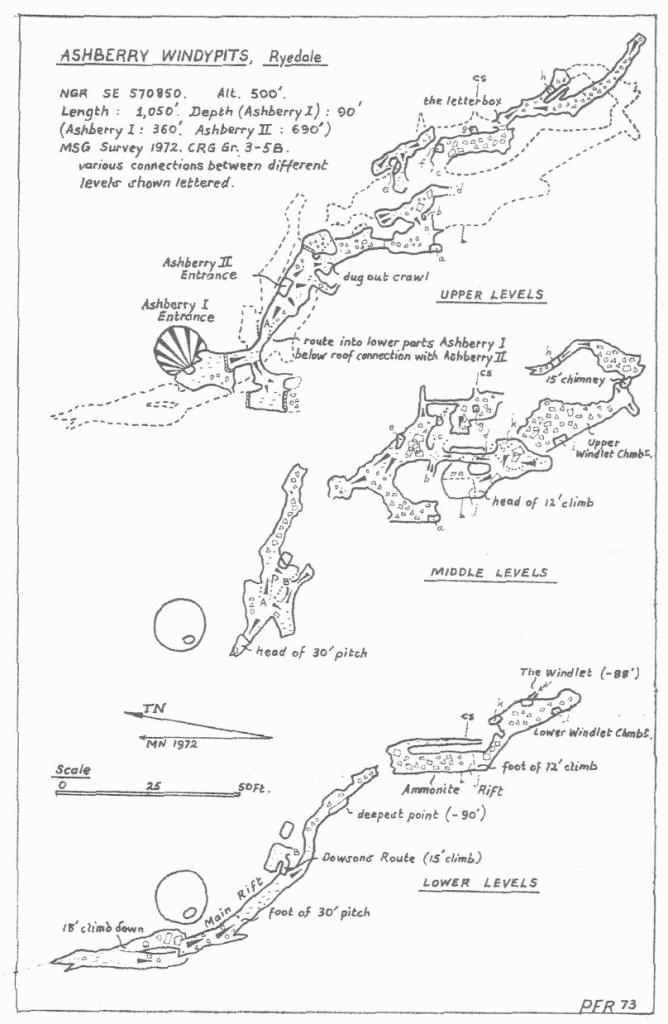
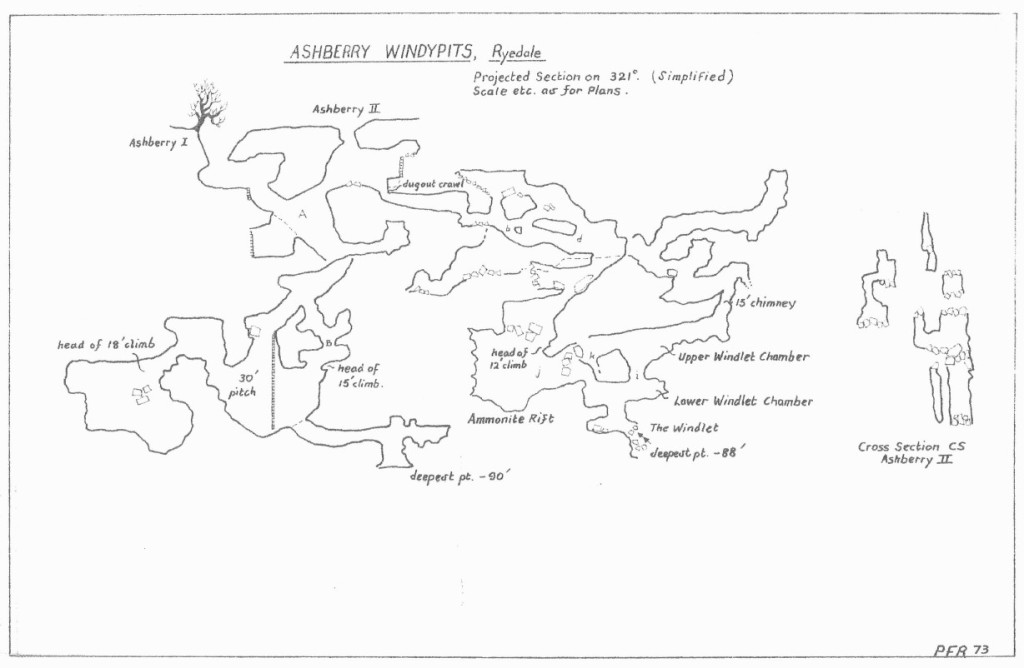
Pennine Underground (1965)
ASHBERRY WINDYPIT, Ryedale D.P.
Alt. 500 feet N.G.R. SE571.850 Depth 90 feet
First explored November, 1935, Y.R.C. 150 feet from N. end of wood on Ashberry Bank, where it flattens. Two entrances, the larger the correct one. First pitch slit and rope descent of 60 feet. Second pitch 30 feet (ladder is best) into rift. N. of rift squeeze into small chamber. Rope needed for 15 feet muddy pitch. Tackle required — 150 feet rope belayed to tree.
BCRA Cave Science – Vol.2 No.12 – The Ryedale Windypits (1950)





